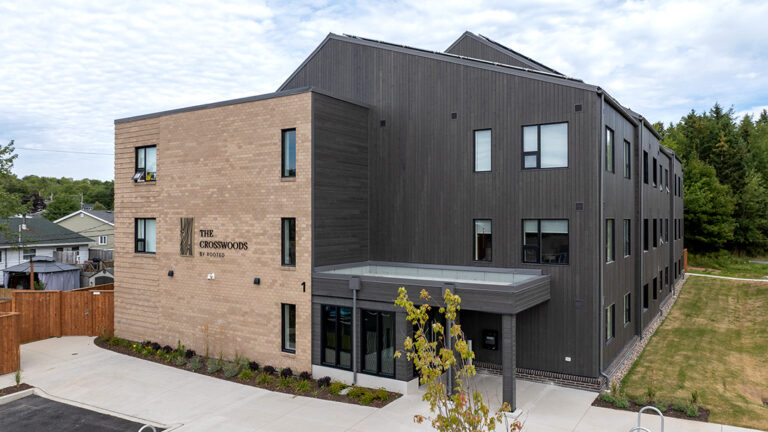Cities need a core of essential workers who typically earn less-than-average wages, but what happens when these workers can’t afford to live in the very cities they serve? A study by WoodGreen Community Services and the Toronto Region Board of Trade took a deep look at the problem and offered some ways forward.
Finding affordable housing is an increasingly difficult challenge in many cities across the country—even for those with steady jobs. In Toronto, where the cost of housing has been notoriously high for a long time, the situation has become so problematic that many workers are either struggling to stay, decide to quit, or have never been able to live where they work. All of these scenarios have their drawbacks and consequences.
Recognizing the urgency of the situation, the Toronto-based non-profit organization WoodGreen Community Services and the Toronto Region Board of Trade have been tackling the workforce housing issue for months. Between January 2020 and July 2021, they published the Housing a Generation of Workers series, the result of their joint research. The three components are Defining the Problem, Modelling Solutions and The Cost of Inaction.
Here is an overview.
What is workforce housing?
As envisioned by WoodGreen and the board of trade, workforce housing consists of units intended for households that earn more than the maximum established to be eligible for social housing, but which also can’t find housing that meets their budgets.
The series thus focuses on the need for affordable housing for workers earning between $40,000 and $65,000 a year, “people who serve the city and yet can’t afford to live in it.”
This includes workers from the restaurant, health, education and social-services sectors, and those working in stores such as groceries and pharmacies.
Workforce housing may refer to lodging owned by a company and made available to its employees. But tying housing to an employment relationship can raise ethical questions. That’s not how WoodGreen and the board of trade look at it, however.
“We’re not suggesting [this] like in a mining town,” says WoodGreen vice president of policy and strategy, Michelle German. “We don’t think that there should be a strong tie [between the employer and the housing].
“It’s more about employers being part of the housing solutions. So, if a downtown city hospital has land that it’s redeveloping, it’s to see how it might produce affordable housing for people within that bracket who may or may not work for them.”
A worsening portrait
Toronto housing shortage is such that even households with higher-than-median incomes ($71,631 in 2019) have difficulty accessing appropriate and affordable housing, according to Housing a Generation of Workers.
So imagine the challenge faced by workers who earn less than the median, such as dental assistants, social workers and secretaries (average annual salary of $54,880) or security guards and data entry clerks ($43,920). There are 90,000 essential workers in Toronto earning between $40,000 and $60,000 a year.
According to the report, house prices rose four times faster than revenues in 2018, and “rent increases were double wage increases.”
The report also examines the wage premium often associated with the Greater Toronto Area (GTA Wage premium). There are two types: the “required premium” (the wage boost required to offset the high costs of housing in the region) and the “actual premium” (the wage enhancement actually offered aimed to offset the cost difference). According to the report, the actual premium associated with several jobs in the Toronto area is negligible or non-existent.
Truth and consequences
The consequences—and varied costs—of skyrocketing housing prices are numerous. According to the report, “the GTA’s housing problem has now become an employer problem.”
An analysis done specifically for this study by Prism Economics shows that the direct and indirect costs of the GTA housing affordability crisis range between $5.88 billion and $7.98 billion a year.
These costs are due to wage pressures on employers, costs associated with employee migration out of the Greater Toronto Area, employee turnover rates and recruitment, costs resulting from lost productivity due to worker travel time, or other types of economic consequences such as the fact that when a household allocates too much of its budget for housing, it has less money to consume other goods.
“My problem with moving to Toronto is that I’d have to be paying at least $1,600 a month [for an apartment], which I can’t afford,” says Juliana, a 60-year-old substitute teacher for the Toronto School Board who lives in her friend’s basement in Hamilton. “[Toronto] literally is a Catch-22,” she told the study authors. “It offers so many employment [opportunities], but you cannot afford to work there because housing is expensive.”
It was important for WoodGreen and the board of trade to calculate these costs because, German argues, “when you talk about effects on the economy [the stakes] become less partisan. They become facts.”
There are also social consequences. The last of the three report elaborates on the loss of quality in education, the increase in gender inequality, limitations in care for the elderly, as well as the loss of experienced workers. As soon as they have other job opportunities, they leave the city.
“It creates a brain drain and it also enforces problematic power dynamics,” notes German. “It also deprives the city of a certain texture you get when you have all these different ages of people.”
Better models?
The second report in the series proposes three case studies of existing projects, evaluating them according to “principles of a good workforce housing model.” These principles include land maximization, long-term affordability and model replicability.
“When you’re dealing in community housing or social housing for specific end users, there’s always going to be a level of specificity that’s required,” notes German. “However, there’s a lot of things that could be the same. There can be a bit of a checklist of things you can do to set yourself up for success,” such as the use of certain grants from the government, working with a certain developer or using a certain program.
“The [example] that we liked the most is a co-op,” says German. Located in the Church-Yonge area, this project is the result of a partnership initiated by a city councillor that involved unionized workers in the hotel and food-services industry. It has 85 units, a training centre and a communal restaurant.
The report also identifies emerging models and trends, such as lifetime affordable housing systems or the creation of communal assets through community trusts.
What needs to be done?
“The story that emerged is that people are getting pushed out of the city and we’re building a city that’s going to be for the super-rich and the super-poor,” German says.
The study offers three key recommendations: models must be scaled to work in other contexts or realities, the development of the business case and research must continue, and a housing strategy for workers must be implemented.
It also notes that that in order to implement housing solutions that can be replicated and are adaptable, you have to have creative partnerships, leverage density for mixed-income development and put future residents’ needs first.
Finally, the study argues that “housing should be seen as a critical component of economic development strategies – because companies and organizations cannot create new jobs if there are no places for their workers to live.”



